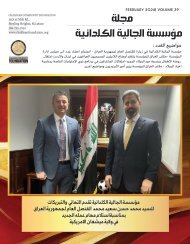You also want an ePaper? Increase the reach of your titles
YUMPU automatically turns print PDFs into web optimized ePapers that Google loves.
IRAQ today<br />
Working the ‘Road of Hell’<br />
with Iraq’s Army<br />
BY SUDARSAN RAGHAVAN<br />
Hachim Al-Sultan, Iraq/Washington Post<br />
Over 24 hours, I learned that in this<br />
place, your next step could easily be<br />
your last.<br />
So there I was, with a colleague, staring<br />
at the gaping hole in the wall. On the other<br />
side was the school — rigged with explosives,<br />
we were told.<br />
In such situations, a moment can seem like<br />
eternity — more so when you have watched a<br />
man dying in front of you or when you have<br />
come close to meeting death yourself. I had<br />
experienced both, less than 24 hours earlier.<br />
The day before, I was walking on a dusty,<br />
rugged strip that local villagers called the<br />
Road of Hell. I was with Washington Post<br />
photographer Andrea Bruce and our Iraqi<br />
translator, Zaid Sabah. On that August day,<br />
we were embedded with the Iraqi army and<br />
had arrived with Gen. Ali Ghaidan, their top<br />
commander in Diyala province. The road was<br />
clogged with U.S. and Iraqi vehicles. The<br />
bomb sweepers were working. The sun was<br />
burning like a furnace.<br />
Gen. Ghaidan and his entourage walked<br />
up and down the road. Then he left, leaving<br />
us with the Iraqi Army’s 1st Division, 3rd<br />
Battalion. Less than a half hour later, the<br />
explosions began. There was the detonated<br />
one, near where Ghaidan stood. Maj. Adil<br />
Muhammed, the head bomb sweeper, found<br />
it and quickly disposed of it.<br />
Then there was the blast nobody expected.<br />
An American armored bulldozer had run<br />
over an anti-tank mine in a stretch of road that<br />
was supposedly clear. Minutes earlier, I had<br />
walked by that spot a couple of times, contemplating<br />
whether to interview the American<br />
soldier seated inside the bulldozer. I didn’t.<br />
When the explosion happened, Zaid and I<br />
were about 30 feet away. Andrea was inside<br />
a Humvee on the other side of the bulldozer.<br />
My first thought was that Andrea had been<br />
hit, and later Maj. Muhammed informed us<br />
that he and his men had thought the same. I<br />
ran toward the black column of smoke as<br />
injured Iraqi soldiers emerged. Fortunately,<br />
Andrea was unharmed.<br />
“We saw a piece of tire fly into the air, and<br />
we thought she was killed,” said Sgt. Hassan<br />
Shegas, 31, another bomb sweeper.<br />
About an hour later, a white flatbed truck<br />
drove fast across the barren plains, bouncing<br />
like a boat on the high seas, heading toward<br />
the road. In the bed was Nazar Ayed, an Iraqi<br />
soldier in his 20s. A sniper had shot him.<br />
When the truck reached the tangle of vehicles<br />
on the road, Ayed was motionless. His<br />
feet were yellow from a lack of blood. His comrades<br />
thought he was dead and left him on the<br />
stretcher. Ten minutes later, someone noticed<br />
that his heart was faintly beating and<br />
informed the Americans.<br />
As Muhammed and other Iraqis<br />
watched, a group of U.S. soldiers<br />
quickly huddled around Ayed, struggling<br />
to revive him. They inserted an IV<br />
into his arms and closed his wound.<br />
Their leader, 1st Lt. Jeffery Wright,<br />
was not satisfied. The tall, wide-shouldered<br />
Georgia native urged his men to<br />
focus on keeping Ayed breathing.<br />
Two U.S. Blackhawk helicopters<br />
landed in a patch of sand and shrubs.<br />
Iraqi and American soldiers carried<br />
Ayed on a stretcher to the lead aircraft,<br />
then walked backed in silence,<br />
covered in dust. He died later.<br />
At the wall of the school, these memories<br />
were speeding through my mind,<br />
mingling with concern of the unknown.<br />
Andrea was there, too, motionless.<br />
A few minutes earlier, the last<br />
remaining residents of this wisp of a village<br />
that looked like a Spaghetti<br />
Western set had told us that they had seen<br />
insurgents walk into the school carrying explosives.<br />
Muhammed and Shegas had hopped<br />
over a wall a few feet away, instead of rushing<br />
through the opening. We thought surely that<br />
was a sign the school had been mined.<br />
But then an Iraqi soldier ran through the<br />
opening and made his way to the school<br />
buildings. Then Zaid did the same. As he<br />
walked, he looked back at us.<br />
Saddam’s<br />
luxury<br />
train to<br />
return to<br />
service<br />
BY SAMEER N. YACOUB<br />
Baghdad/AP<br />
Saddam Hussein’s private<br />
luxury train, equipped with<br />
chandeliers and Italianmade<br />
curtains, is being put into<br />
public service next month to help<br />
ease a train shortage, Iraqi rail<br />
officials said.<br />
Motionless, we stared at him. Crazy Iraqi<br />
translator, I thought.<br />
“Come on, don’t you want to do your<br />
reporting?” Zaid asked me.<br />
Andrea and I looked at each other, our<br />
pride taking over.<br />
We stepped into the compound.<br />
Reprinted courtesy of the Assyrian International<br />
News Agency, www.aina.org.<br />
The 23-carriage French-built<br />
train was kept in a secret location<br />
for three decades and shielded<br />
from the widespread looting that<br />
followed the U.S.-led invasion of<br />
Iraq in 2003.<br />
Starting this month, the train will<br />
ferry passengers between<br />
Baghdad and the southern city of<br />
Basra, said Karim al-Tamimi, a<br />
spokesman for Iraq’s rail system.<br />
He said the train, which also has<br />
three locomotives, was moved<br />
recently from a rail yard in Baghdad<br />
to the city’s main railway station.<br />
Saddam used the train only<br />
once in the late 1970s, shortly after<br />
becoming president, for a trip to<br />
Basra, said Khadum Abdul-Wahid,<br />
the head of the Basra railway<br />
branch.<br />
The train’s carriages are airconditioned<br />
and equipped with TV<br />
screens, officials said. Windows<br />
An Iraqi army<br />
soldier from the<br />
3rd Battalion,<br />
2nd Brigade<br />
5th Iraqi Army<br />
Division<br />
are draped with Italian-made curtains<br />
and chandeliers hang from<br />
the ceilings. Some compartments<br />
served as offices, including a<br />
library, while others were furnished<br />
as living rooms. The train also has<br />
several restaurants and luggage<br />
compartments.<br />
It was not immediately clear<br />
whether some of the expensive fixtures<br />
would be removed before the<br />
public uses the train. Al-Tamimi<br />
said the train is in good shape and<br />
only requires simple maintenance.<br />
Currently, the Baghdad-Basra<br />
train runs only once a day, with three<br />
carriages. Al-Tamimi said railway officials<br />
are now considering reinstating<br />
train service between Baghdad to<br />
the northern city of Mosul.<br />
Iraq has suffered a train shortage<br />
because of years of U.N. economic<br />
sanctions and looting following<br />
the U.S.-led invasion.<br />
PHOTO BY STAFF SGT. MARK WOJCIECHOWSKI<br />
28 CHALDEAN NEWS <strong>SEPTEMBER</strong> <strong>2008</strong>

















